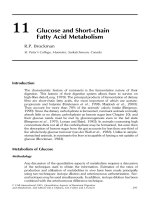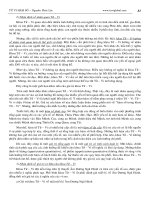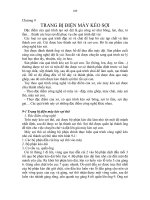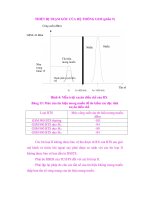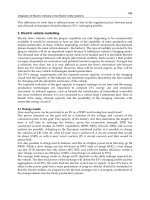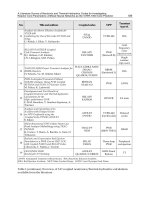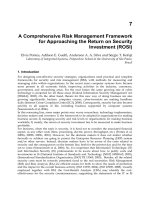Cranes – Design, Practice, and Maintenance phần 9 pptx
Bạn đang xem bản rút gọn của tài liệu. Xem và tải ngay bản đầy đủ của tài liệu tại đây (1.91 MB, 35 trang )
Cranes – Design, Practice, and Maintenance260
Allowed pressures
– Normal duty
σ
v
G100 N͞mm
2
– Heavy duty
σ
v
G85 N͞mm
2
– Very heavy duty σ
v
G70 N͞mm
2
For alternating loads these figures have to be diminished by 30 percent.
D – Design details
In constructions which are being exposed to fatigue loads a number of
design details can often be avoided to prevent fatigue cracks.
The following figures give some of these details.
Fig. 7.6.1 Details of fatigue-sensitive constructions
Construction and Calculation Methods 261
Fig. 7.6.1 Continued
7.7 The natural frequency
The natural frequency of a crane is a very important subject. It is neces-
sary to calculate this figure in order to know whether a crane is stiff
enough, flexible or even shaky.
For cranes with fast running trolleys the natural frequency, in trolley
travel direction, has to be controlled.
Cranes – Design, Practice, and Maintenance262
Fig. 7.7.1 The natural frequency
How to control this
– Using a computer, make a calculation of the displacement in the
horizontal direction of the main- or trolley-girders of the crane
under a particular horizontal force.
Assuming the following:
– weight of complete upperstructure, plus half of the underportal,
plus trolley and load: WG800 tons
– calculated displacement in horizontal direction under load: D G
6mmG0,006 m (measured from quay level up to centre of main
girders).
Then CG
F
D
G
100
0,006
G16 666 kN͞m
Frequency
ω
G
1
C
W
1
G
1
16 666
800
G4,56 rad͞sec
Natural frequency fG
ω
2
π
G
4,56
2
π
G0,726 Hz
Vibration time tG
1
f
G
1
0,726
G1,38 sec
In order to have a good reasonably stiff crane, the natural frequency
should be in the range of f G0,70 Hz.
Chapter 8
Wheels and Tracks
8.1 Calculating the wheel diameters of fast-running
trolleys (
v
>100 m/min)
The best way to calculae the diameter of the trolley travelling wheel is
as follows:
– Calculate the maximum wheel load R maximum (tons).
– Choose a rail width and the material for the rail, being:
Fe510 – (St50): for a rail, welded to the construction.
Fe600 – (St60) or
Fe710 – (St70): for a special, forged rail material.
for Fe510: P
all
G50 kg͞cm
2
for Fe600͞Fe710: P
all
G60 kg͞cm
2
rail width: K (cm)
radius of the curvature
of the rail sides: r (cm)
Fig. 8.1.1 Heavy-duty trolley bogie
Cranes – Design, Practice, and Maintenance264
D
wheel
wheel diameter (cm)
D
wheel
G
R · 1000
P
all
· (KA2 · r)
cm
For the hardness of the rims of the wheels, see under Section 8.2.
8.2 Calculating the wheel diameter of a crane
travelling wheel for normal speeds
(
v
= up to 60 m/min)
Calculate the average wheel load as follows:
R
mean
G
2 · R
max
CR
min
3
where
R
mean
Gaverage wheel load (tons)
R
max
Gmaximum wheel load (tons)
R
min
Gminimum wheel load (tons)
CGrating factor, considered over one hour of crane working time.
Herein is: rating 40 percent: C G1
60 percent CG0,9
80 percent CG0,8
Fig. 8.2.1 Crane travelling bogie with double rails
Wheels and Tracks 265
P
all
:70kg͞cm
2
for a forged
rail of Fe600 or Fe700
Rail width: K (cm)
Radius of the curvature
of the rail: r (cm)
D
wheel
: wheel diameter
D
wheel
G
R
mean
· 1000
C · P
all
· (KA2 · r)
Also check what the maximum static wheel load under the worst con-
dition is, and divide this by 1,25. If the value is bigger than R
mean
, then
augment D
wheel
accordingly.
The hardness of the rims of the crane travelling wheels and trolley
travelling wheels should be approximately 300 HBr.
Delachaux in Gennevilliers, France, has ‘infatigable’ wheels with a rim
which is deep hardened to 400͞450 HBr. The depth of hardness can be
as much as 20 mm.
8.3 Differences in wheel load, due to braking forces
Assume that the horizontal windload per corner is X tons. The X tons
give this horizontal force to the main hinge point of the bogie train.
Fig. 8.3.1 Crane travelling mechanism
Cranes – Design, Practice, and Maintenance266
Fig. 8.3.2 Wheel load scheme through the horizontal force
X
This horizontal force X results in vertical forces on the wheels.
Assuming further, that eight wheels are under each corner, six of which
are driven. As six wheels are driven and braked, these driven wheels
can take X :6G
1
6
X as horizontal force. The scheme in Fig. 8.3.2 shows
this phenomenon. The figures show which vertical wheel load should
be added or subtracted per wheel, as well as the horizontal force per
braked wheel.
Note: In Sections 8.1 and 8.2 the materials have been mentioned in
the well-used nomenclature. The new nomenclature has been mentioned
in Section 7.1.
Fe510 (St50) is S355
Fe600 (St60) is S335
Fe710 (St70) is S360
Wheels and Tracks 267
8.4 Rails and rail constructions
As mentioned earlier the block-rail of the material Fe510 (S355) is very
popular for trolley travelling rails when the rails are welded to the
girders. Rails with a higher strength are often more difficult to weld.
Fig. 8.4.1 Typical crane rail construction
Fig. 8.4.2 Crane travelling rails on sleepers
Cranes – Design, Practice, and Maintenance268
Table 8.4.1 Dimensions, etc. of rails
Head Mom. of Section Neutral
Weight Height width Web inertia modulus axis
Rail G H Base K W J
x
W
x
e
type (kg͞m)(mm) B(mm)(mm)(mm)(cm
4
)(cm
3
)(mm)
F100 57,5 80 100 100 70 414 101 39,1
F120 70,1 80 120 120 90 499 123 39,3
Material: steel with a tensile strength of min. 690 N͞mm
2
A55 32 65 150 55 31 182 46,9 38,8
A65 43,5 75 175 65 38 327 73,6 44,4
A75 56,5 85 200 75 45 545 109 50
A100 75,2 95 200 100 60 888 170 52,1
A120 101 105 220 120 72 1420 249 57
A150 150 150 220 150 80 4373 412 72
BSC164 166 150 230 140 75 4777
MRS125 125 180 180 120 40 6225 681 91,4
MR151 151 150 220 150 80 4271 560 73,7
MRS220 221 160 220 220 115 6890
PR185 R 86,8 152,4 152,4 101,6 34,9 3068 399 76,8
Wheels and Tracks 269
Table 8.4.2 Rail qualities
Steel grade
σ
e
(N͞mm
2
) CMnSiS
max
P
max
Va (N͞mm
2
)
690 0,410–0,520 0,90–1,10 0,15–0,25 0,050 0,060 — 360
780 0,490–0,620 1,10–1,30 0,20–0,30 0,050 0,050 — 400
880 0,580–0,720 1,30–1,60 0,25–0,40 0,050 0,050 — 450
690 Va 0,260–0,380 1,10–1,30 0,20–0,30 0,050 0,050 0,10–0,15 460
780 Va 0,320–0,420 1,10–1,30 0,25–0,35 0,050 0,050 0,10–0,15 500
880 Va 0,420–0,500 1,20–1,40 0,25–0,30 0,050 0,050 0,10–0,15 560
Fig. 8.4.3 Barge cranes
Fig. 8.4.4 Hydraulic-driven crane travelling mechanism in an ore unloader
Cranes – Design, Practice, and Maintenance270
Fig. 8.4.5 Feeding the crane travelling motors of Fig. 8.4.4
Forged crane rails exist in many types, only some of which are men-
tioned here. The newer crane rails often have a crowned rail head (RG
600 mm).
8.5 Trolley travelling rails and boom hinge points
Trolley travelling rails
Trolley travelling rails are often welded to the girders and the booms.
In this case a block-type rail should be used, preferably of steel quality
Fe510 (S355) which has a low carbon content.
Heavy duty constructions, permitting high wheel-loads can be made
with forged crane rails. These rails include C, Mn, Si. Vanadium could
be included when the loads and the frequency of overrollings are high.
Fastening these rails to the girders should be done with clips. The
rails are then normally laid on a flexible pad.
Boom hinge points
The boom hinge points are rather vulnerable. Many different types are
used. It is most important that the construction is stiff, and that the
load carrying parts should not be able to deflect. If the rail components
in the hinge points are hardened, this is a useful feature.
Wheels and Tracks 271
Fig. 8.5.1 Clipped trolley rail
Fig. 8.5.2 Very heavy-duty construction
Cranes – Design, Practice, and Maintenance272
Fig. 8.5.3 Boom hinge point in heavy-duty ore unloader
Fig. 8.5.4 Boom hinge point of a container crane
Wheels and Tracks 273
Fig. 8.5.5 Special construction of a hinge point
Fig. 8.5.6 Bronze bushed hinge point
Cranes – Design, Practice, and Maintenance274
Fig. 8.5.7 Detail of hinge point of Fig. 8.5.3
Fig. 8.5.8 Hinge point with widened rail
Wheels and Tracks 275
Fig. 8.5.9 Lowering the boom: closing the gap
When the rail is laid on a flexible pad, the pad should be tapered
approximately one metre in front of the hinge point. To compensate
for this, and to keep the rail level, a correspondingly tapered steel plate
section is laid underneath the rail. This tapered section allows the rail,
which is somewhat flexible in the vertical plane, to have a transitional
trajectory in front of the fixed and non-flexible part of the rail at the
boom hinge point. If this is not configured correctly, the rail will frac-
ture at the weakest point. The weak point is directly behind the weld,
between the boom hinge point and the section of rail laid on the flexible
rail pad.
Cranes – Design, Practice, and Maintenance276
8.6 Wear and tear of a crane rail
This is a very subjective issue for which a good calculation method
cannot be given. Professor Dr Ir. Van Iterson mentioned in 1949 the
following manner of comparison of the lifetime of crane rails:
Assume that the allowed wheel load is:
PG50 ·b·D(kg)
Assume that the rails are made of Fe510 and that the wheels are of
a better quality. In this case it can be further assumed that the rails
are worn out after about one million (10
6
) passages of the crane
wheel.
For heavier or smaller loads the lifetime decreases or increases with
the third degree of the load:
P
3
1
:P
3
2
Gn
2
:n
1
or
n
1
· P
3
1
Gn
2
:P
3
2
Whatever we calculate:
– Lining out the wheels correctly is most important to prevent wear
and tear of rails and wheels.
– The skew of a crane or trolley is a major cause of wear and tear
of rail and wheels.
8.7 Buffers
Cranes are provided with buffers which are intended to cushion the
impacts when cranes crash into each other, or into the endstops on the
crane tracks. Trollies are provided with buffers which are intended to
cushion the impacts when the trolley bumps on to the endstops on the
trolley tracks.
Polyurethane elastomer buffers
The micro-cellular structure allows rather high deflections. The material
has good resistance against attack by grease, oil, aging and ozone and
can be used also in temperatures as low as −15°C. These buffers can
provide a deflection of approximately 50 percent of the original height
of the buffer.
Wheels and Tracks 277
Fig. 8.7.1 Example of a polyurethane buffer
After having calculated the kinetic energy, E, which has to be
absorbed, a suitable buffer can be chosen using the available diagrams
which demonstrate their properties.
EG
Q
t
2
û
2
Nm; Q
t
in kg; û in m͞sec; motors non-driving
Fig. 8.7.2 Comparison between two buffer types
Cranes – Design, Practice, and Maintenance278
An example of such a diagram is given for a buffer
φ
500 mm with a
length of 700 mm in Fig. 8.7.1.
Hydraulic buffers
This type of buffer incorporates energy absorption by the displacement
of a hollow plunger within the buffer. When the crane or trolley is being
driven slowly, the resistance of the buffer is low. This means that the
crane or trolley can then use the maximum track length.
Chapter 9
Miscellaneous
9.1 Overload preventers
The main principles concerned are:
1. Overload preventers with strain gauges or load cells.
2. Overload preventers with load measuring pins.
Overload preventers with strain gauges
The strain gauges or load cells can be built-in directly behind a dead-
end of a hoisting wire rope or in a yoke which is carrying wire rope
sheaves, or underneath a gear-box. Usually the crane driver can check
the approximate weight of the carried load on a display in his cabin.
Overload preventers with load measuring pins
High quality stainless steel load pins contain strain gauges which are
mounted in a particular way which give a load proportional signal. The
load measuring pins can be built-in in a wire rope sheave or in the pin
of a hydraulic cylinder. Load monitoring can also be done in the crane
drivers cabin etc.
9.2 Snag loads
Occasionally, when a crane driver is joisting a container out of a cell,
the container jams because of irregularities in the cell guides. The hoist-
ing winch has to stop in a very short time, as the container snags. In a
container crane with a rope trolley, there is a considerable length of
Cranes – Design, Practice, and Maintenance280
Fig. 9.1.1 Overload preventer
Fig. 9.1.2 Load measuring pin
hoist wire rope, because it runs from the boom end to the trolley, from
the trolley to the spreader, and back to the trolley, and from there to
the hoisting winch, situated at the rear end of the bridge. This wire rope
length will be between approximately 130 and 250 m.
The jamming of the container into the cell, causes an abrupt stop to
the hoisting winch and results in a lengthening of the hoisting wire
ropes.
∆lG
F · l
A · E
cm
Miscellaneous 281
where
∆l Gelongation of the wire rope in cm
F Gthe rope pull in kg
l Gthe total wire rope length as mentioned in cm
A Gthe net area of the cross section of the wire rope in cm
2
E Gthe elasticity module; say EG1,000,000 kg͞cm
2
(10
6
kg͞cm
2
).
The hoist wire rope has a normal safety factor against rupture of about
6. This means that when a considerable wire rope length is stretched by
the abrupt halt, the rope elongation, ∆l is also considerable.
Under normal speed and load conditions the snag-load will stop the
winch without damaging anything, but the safety factor of the wire rope
against the rupture will diminish considerably under the snag con-
ditions, e.g. to
ν
G1,5 or 2.
Fig. 9.2.1 Snag load system
With a machinery trolley the wire rope length which may be elon-
gated by an abrupt halt is much shorter. Only 30 to 40 m may be
affected when a container jams in a cell directly under the desk of the
vessel. It would, therefore, be useful to build in a snag preventer into
the construction, thereby preventing problems with container ships with
poor cell guides. A fast working snag-damper system can be built in
Cranes – Design, Practice, and Maintenance282
within the machinery trolley comprising 4 snag-dampers each of them
with a stroke of approximately 1,5 m and each of them acting on a
fixed end of the hoisting wire rope.
The stroke of 1,5 m allows the drum with a diameter of 1,2 m to stop
within a rotation of:
1,5
π
· 1,2
· 360 degreesG143 degrees or
over a distance measured over the circumference of the drum of also
1,5 m.
The hoisting winch may for example have motors with a maximum
torque of f
a
G1,6. The snag damper system must then give way when
M¤1,6 Mn, let us say at f
a
G1,8 and immediately the motor current
must then be brought to zero. An emergency stop must be commenced
to stop the winch.
If there is a ‘concentric snag’, all four wire ropes will be overloaded.
If there is an ‘eccentric snag’, only two wire ropes are overloaded. These
wire ropes have to stop the winch in the same stroke. The overload in
these ropes under eccentric snag conditions will be twice as bad as under
concentric snag conditions.
If the crane driver wants to hoist with an empty spreader at higher
speeds (field-weakening speeds) and the spreader jams into the cell, the
overload in the wire ropes becomes still higher, due to the higher motor
speeds, which means a longer braking time.
Example
Machinery trolley Full loaded Trolley with
Scheme (Fig. 9.2.1) trolley empty container
Hoisting speed of the load
within the cells of the ship:
û(m͞min) ûG60 m͞min ûG90 m͞min
Wire rope speed on the drum:
û
l
G(2û : 60) (m͞sec) û
1
G2m͞sec û
1
G3m͞sec
Hoisting capacity on the
ropes: Q (tons) QG66 t QG18 t
Miscellaneous 283
Fig. 9.2.2 Snag load forces in system according to Fig. 9.2.1
Machinery trolley Full loaded Trolley with
Scheme (Fig. 9.2.1) trolley empty container
Snag Eccentric Eccentric
Nos. of revolutions of the
hoisting motor(s) nG783 rev͞min nG1175 rev͞min
ω
G(n
motor
:60) ωG81,95 rad͞sec ωG123 rad͞sec
·2
π
rad͞sec
Inertia movement on
motorshaft from motor(s),
brake sheaves and gear box:
J
rot
(kg m
2
) J
rot
G46 kg m
2
J
rot
G46 kg m
2
Brakes will be in action after
∆
t
sec ∆
t
G0,3 sec ∆
t
G0,3 sec
Effective brake movement:
M
b
(Nm) M
b
G18 050 Nm M
b
G18 050 Nm
Snag damper system gives
way when f
a
G1,8. The motor
current is then immediately
switched to zero
Cranes – Design, Practice, and Maintenance284
Machinery trolley Full loaded Trolley with
Scheme (Fig. 9.2.1) trolley empty container
In ∆
t
G0,3 sec the wire rope
on the drum with diameter
DG1,2 m travels over the
circumference of the drum
over the ‘overrun stroke’ of:
S
1
G∆
t
·û
1
(m) S
1
G0,3 · 2G0,6 m S
1
G0,3 · 3G0,9 m
Attention:
The snag damper system must
be able to follow the stroke S
in the available – very short
time in order to prevent over-
stretching the wire ropes!
During mechanical braking
the effective braking time
becomes:
t
brake
G
ω
· J
rot
M
b
(sec) t
b
G
81,95 · 46
18 050
t
b
G
123 · 46
18 050
t
b
G0,21 (sec) t
b
G0,31 sec
During t
b
sec, the wire rope
on the drum travels over the
circumference of the drum
over:
S
2
G
1
2
· û
1
· t
b
(m) S
2
G
1
2
· 2 · 0,21 S
2
G
1
2
· 3 · 0,31
G0,21 m G0,465 m
The total absorbed wire rope
length is:
S
t
GS
1
CS
2
(m) S
t
G0,6C0,21 S
t
G0,9C0,465
G0,81 m G1,365 m
The stroke of the snag
damper is:
S
d
(m) S
d
G1,5 m S
d
G1,5 m
Result: The wire ropes are not overstretched any more, so the wire
rope safety factor is not reduced further than
ûG
6
1,8
Gapproximately 3
